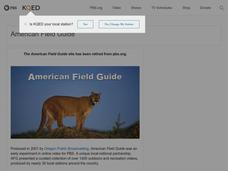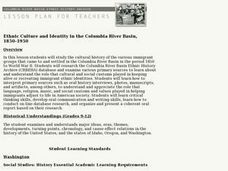Curated OER
Salmon Vs. Dams: the Dam Removal Debate on the Elwha River
Students role-play a meeting of the Elwha River council in which they present opposing views to council members on hydroelectric power and salmon fisheries resources. They brainstorm possible conflicts between various people in land-use...
Curated OER
Relative Dating-Telling Time Using Fossils
Students explore how to read fossil range charts. They develop an knowledge of the strengths and weaknesses of the fossil record. Students become familiar with the concepts index fossil and fossil range. Students use bar graphs to...
Curated OER
The West "The People": The Lewis and Clark Expedition
Fourth graders become familiar with the conditions facing the members of the Expedition in the early 1800's, as well as the causes and consequences of the Expedition. They describe the conditions of the land in the 1800's and during the...
Curated OER
Ocean Habitats:
Students investigate the creatures of intertidal zones. They explore the adaptations species make to survive .
Curated OER
Fires and Fire Suppression
Students examine their assumptions about forest fires. They explore the conflicts involved with the forest service's new strategy. in addition, they will study one case where a prescribed natural burn had a significant impact on a later,...
Curated OER
Floods: Rising Waters and You
High schoolers will examine how floods work and why they can cause so much damage and destruction. They use a stream table to observe the processes that lead to flooding and the effects of floods on human-made structures. Includes a...
Curated OER
Co-evolution of Plants and Pollinators
Students explore biological evolution and natural selection and its evolutionary consequences. They also explore how organisms are interdependent on one another.
Curated OER
Mammals: Mammals and Their Ways
Young scholars, in groups, observe, collect data, and analyze mammal behaviors.
Curated OER
Ecotourism in National Parks and Wilderness
Students develop a plan for ecotourism after researching a nearby national park or wild area.
Curated OER
Native Species Restoration and its Impact on Local Populations
High schoolers explore how predators help control the growth of prey species for a more balanced ecosystem.
Curated OER
Non Native Species: English Ivy-Landscape Plant or Deadly Killer?
Students study the impact that invasive species have on biodiversity and more natural areas.
Curated OER
The Formation and Value of Temperate Grasslands
Students get an overview of the climate and organisms of the North American Prairie. After a lecture, and watching some videos imbedded in this plan, students compile research data on the North American Prairie.
Curated OER
Simple Thermodynamics of Transportation
Students watch videos about various modes of transportation, they examine the energy transformations that occur in each, and they be introduced to the laws of thermodynamics.
Curated OER
Mammals: Mammals and Their Ways
Students study the difference between innate and learned behaviors. They observe the adaptations and behaviors of mammals in this series of lessons.
Curated OER
Landfills: A Solid Waste Management Plan
Young scholars are able to list the types of household waste that they produce daily. They are able to describe some other types of waste that are produced by industry or agriculture to help maintain their lifestyles. Students are able...
Curated OER
Flowers and Plants
Students are assigned to bring five flowers. They explore flowers to distinguish different physical features of flowers. They compare and contrast different flowers to determine what features they have in common. Students develop an...
Curated OER
Ethnic Culture and Identity in the Columbia River Basin, 1850-1950
Students explore cultural history of immigrant groups that settled in the Columbia River Basin from 1850 to World War II, and examine various primary sources to explore role cultural and social customs played in keeping alive immigrant...
Curated OER
"Where In The World Am I?" Creating a Travel Brochure for Japan
Students create a travel brochure for the country of Japan.
Curated OER
Reading Comprehension: Oregon
In this reading comprehension worksheet, students read a 2-page article regarding Oregon and respond to 10 true or false questions regarding the selection.
Curated OER
Big Trouble in the New Frontier: The Bay of Pigs
Eleventh graders explore the Bay of Pigs invasion and defend both sides of the issue.
Curated OER
Relative Dating - Telling Time Using Fossils
Learners use fossil range charts to explain relative dating. They graph for ammonites, marine organisms that went extinct at the same time as dinosaurs.
Curated OER
Threatened Species and Public Policy
Students discuss the Endangered Species Act and its impact on people and the environment. They read the act and watch video footage. They examine why sea turtles are endangered and efforts to protect them. They analyze numerical results...
Curated OER
Ecotourism in National Parks and Wilderness
Middle schoolers research a wilderness or natural area and develop a plan for ecotourism.
Curated OER
Testing the Caverns
Students build model caverns using paper mache or clay and bury them in a tray of sand. They test the models by dropping balls onto them to simulate an asteroid hitting the earth. They evaluate the effectiveness of a structure against...

























